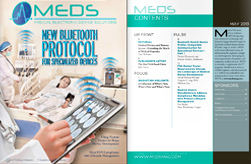The following is a high-level overview of the processes required to get a new medical device classified and approved by the Food and Drug Administration (FDA). This paper attempts to present complex regulatory processes in the simplest possible terms. Where applicable, it includes links to resources that contain detailed background information. When submitting a medical device for FDA approval, it is vital to read and understand all of the underlying regulations. The information presented here is for informational purposes only. Those attempting to navigate through the FDA approval process for the first time are strongly advised to seek professional assistance from an organization with broad expertise and experience in regulatory issues.
Before beginning the submission process, the applicant must verify that the product qualifies as a medical device by the FDA’s definition. Drugs and some other medical products are subject to different regulations than medical devices. A drug is relatively easy to define: If the primary intended use of the product is achieved through a chemical action or is metabolized by the body, then the product is usually classified as a drug. Most other medical products are considered medical devices.
A medical device is defined as:
An instrument, apparatus, implement, machine, contrivance, implant, in vitro reagent or other similar or related article, including a component part or accessory, which is:
- Recognized in the official National Formulary, or the United States Pharmacopoeia, or any supplement to them.
- Intended for use in the diagnosis of disease or other conditions, or in the cure, litigation, treatment or prevention of disease in man or other animals, or
- Intended to affect the structure or any function of the body of man or other animals, and which does not achieve any of its primary intended purposes through chemical action within or on the body of man or other animals, and which is not dependent upon being metabolized for the achievement of any of its primary intended purposes.
Medical devices are subject to the general controls of the Federal Food Drug & Cosmetic (FD&C) Act, which are contained in the final procedural regulations in the Title 21 Code of Federal Regulations Part 800-1200 (21 CFR Parts 800 – 1299). These controls comprise the baseline requirements that apply to all medical devices. Specifications are included for marketing, proper labeling and performance monitoring once the device has been released to the marketplace.
Medical Device Classifications
Once a product has been defined as a medical device, the next step is to determine its classification. The FDA will classify your device into one of three classes: Class I, Class II or Class III. The device will also be subject to one of three Marketing Approval processes: Exempt Device, 510(k) or PMA.
Device Class and Regulatory Controls
1.) Class I General Controls
- With Exemptions
- Without Exemptions
2.) Class II General Controls and Special Controls
- With Exemptions
- Without Exemptions
3.) Class III General Controls and Pre-market Approval
Generally, these three classes are determined by the patient risk associated with your device. Typically, low-risk products like tongue depressors are defined as Class I devices, and high-risk items like implantable defibrillators are defined as Class III devices. The marketing approval process is usually determined based on a combination of the class of the device and whether the product is substantially equivalent to an existing FDA-approved product. If the device is a Class I or a subset of Class II and is equivalent to a device marketed before May 28, 1976, then it may be classified as an Exempt Device. A 510(k) is a pre-marketing submission made to the FDA that demonstrates that the device is as safe and effective (substantially equivalent) to a legally marketed device that is not subject to Pre-market Approval (PMA). For the purpose of 510(k) decision-making, the term “pre-amendment device” refers to products legally marketed in the U.S. before May 28, 1976 and which have not been:
- significantly changed or modified since then; and
- for which a regulation requiring a PMA application has not been published by the FDA.
PMA requirements apply to Class III pre-amendment devices, “transitional devices” and “post-amendment” devices. PMA is the most stringent type of product marketing application required by the FDA. The device maker must receive FDA approval of its PMA application prior to marketing the device. PMA approval is based on the FDA’s determination that the application contains sufficient valid scientific evidence to ensure that the device is safe and effective for its intended use(s). For some 510(k) submissions and most PMA applications, clinical performance data is required to obtain clearance to market the device. In these cases, trials must be conducted in accordance with the FDA’s Investigational Device Exemption (IDE) regulation.
Labeling, Registration and Listing Requirements
All FDA marketing approvals require labeling, registration and listing. Before it obtains clearance to market its device, the manufacturer must assure that the device is properly labeled in accordance with FDA regulations. Once marketing clearance has been obtained, the manufacturer must register its company and list the device it plans to market with the FDA. The registration and listing process is accomplished via the FDA’s Unified Registration and Listing System (FURLS). After marketing approvals have been granted, a manufacturer must comply with post-market surveillance controls. These include Quality System (QS) and Medical Device Registration (MDR) regulations.
The QS regulation—also known as Good Manufacturing Practices (GMPs)—is a quality assurance requirement that covers the design, packaging, labeling and manufacturing of a medical device. The MDR regulation is an adverse event-reporting program.
For more information contact:
Bruce Swope
Vice President of Engineering
t: 201.227.7569, ext. 144
[email protected]
www.sterlingsmartware.com

